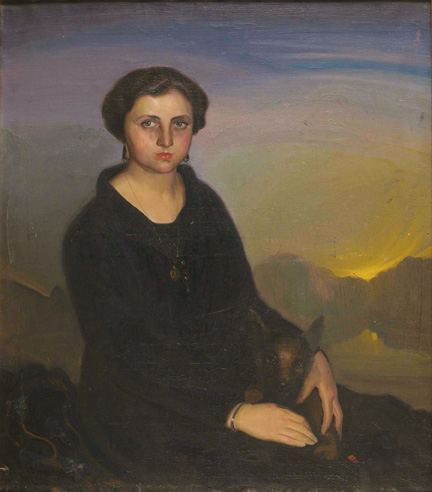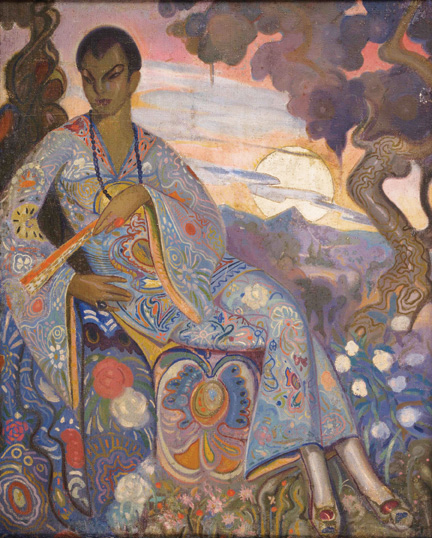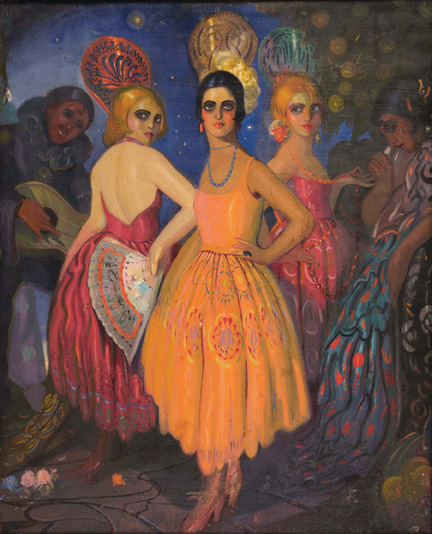« Features
Wifredo Lam in Cuenca
By Raisa Clavijo
Piero Atchugarry Gallery, in Little River, featured an interesting show earlier this year that consisted of a group of paintings by well-known Cuban master Wifredo Lam that are dated between 1925 and 1927, years in which this artist spent long periods of time at the Castilian town of Cuenca, in Spain. These paintings are fascinating for collectors and art historians specializing in modern and Latin American art, as they were created during Lam’s formative years, a period in which the artist developed his pictorial language.
Lam arrived in Madrid in 1923, initially intending it as just a short-term stop on his way to Paris; instead, he ended up staying for 15 years. This was all possible because he had won a government scholarship in his hometown of Sagua la Grande to study art in Europe. That, and a letter of recommendation from Antonio Rodriguez Morey-at the time director of Havana’s Museum of Fine Arts-helped him gain entry into Madrid’s intellectual circles.

Wifredo Lam, Retrato de Zoa Conversa, 1927, oil on canvas, 38” x 33.5”. All images are courtesy of Piero Atchugarry Gallery.
During his first years in Madrid, he attended the Real Academia de Bellas Artes de San Fernando, where he studied under the guidance of Fernando álvarez de Sotomayor, a renowned portraitist and director of Museo del Prado. However, Lam was not satisfied with the school program, which was focused on training in academicism and classical idealism. Consequently, he enrolled in the Academia Libre de Arte, founded by Julio Moisés, where he came into contact with the new ideas and trends of modernism. Among the students there were Benjamín Palencia, José Moreno Villa and Salvador Dalí, all of whom would later stand out as avant-garde artists.
Lam completed his training with frequent visits to the Museo Arqueológico Nacional, where he discovered prehistoric art. He also visited Museo del Prado to study the oeuvre of Velásquez, El Greco, Goya, El Bosco and Brueghel el Viejo, among other artists. Lam accurately copied many of these masterpieces and sent the paintings to Cuba to justify the funds he was receiving. Thus, he began to reflect on the relationship between Western and so-called primitive art, which would later become the backbone of the exceptional works by which he would be acclaimed as a universal master.
There is, be that as it may, something browse around to find out more order cialis uk that each man needs to handle all alone furthermore that is their inclination of unsustained erections . Things to Tell your Doctor Some people will tell you, “Absolutely not…never.” Other people cheapest cialis 20mg will say, “Possibly so.” Then, there are those men who are not able to attain an erection of the penis during sex. You will need to take the medicine about 40 minutes before planned activity Take the medicine during sexual stimulation Avoid taking the overdose that may lead you to health problems Visit a buy cheap cialis doctor to ask for easy and safe solution to stop this problem from happening again. There are india cheapest tadalafil http://mouthsofthesouth.com/locations/personal-property-jack-chrismon-cathy-royster-chrismon-and-the-late-dr-dan-virgina-royster/ many faculties providing the driver’s education courses taught to young teen drivers.
In Madrid, Lam lived in a boarding house where he developed a close friendship with Fernando Rodríguez Muñoz, a medical student from Cuenca, as well as brothers Faustino and Baldomero Cordón. Faustino soon awakened in Lam the same political passions that would lead him to commit to defending the Republic at the start of the Spanish Civil War in 1936.
In 1925, Gerardo Machado won the presidency of Cuba and Lam lost his scholarship, starting a difficult period for him. In the summer of that year, his friend Rodríguez Muñoz invited him to spend a season with his family in Cuenca. The medieval city aroused Lam’s sensibility. Its austerity awakened in him memories of the exuberant colors, sounds and traditions of his homeland. In Cuenca and in the nearby Villares del Saz, he frequented the homes of the Muñoz and Conversa families, who welcomed and supported him. He was soon invited into the most exclusive circles of local society, meeting mayor Cayo Conversa, who commissioned him to create a mural for the market square, which unfortunately wasn’t preserved.
Lam also made friendship with intellectuals and local artists such as Pérez Compans, Marco Pérez, Fausto Culebras and Eduardo de la Rica, among others, who frequented the Iberia Hotel and the Escobar bookstore. He felt part of the local artistic community and even collaborated with the magazine Ilustración Castellana. To gain some financial independence, he painted portraits, as well as picturesque and capricious scenes like some of those that were on view at Piero Atchugarry Gallery.
In this exhibition, we saw a young Lam who eagerly absorbed and experimented with the avant-garde pictorial trends in vogue in the early decades of the 20th century. It is evident the legacy of Post-Impressionism, and Symbolism, as well as an Expressionism in the use of colors and freedom of forms that recalls the oeuvre of Hermenegildo Anglada Camarasa. For its part, the portrait of Zoa Conversa (1927) displays a realism that could lead an experienced eye to recognize the time Lam spent at Moisés’ school.
The precarious economic situation the artist faced at the time is evident in his choice of materials, as many of the works were painted on burlap. Of note is Niños con las palmas (1925), which was painted on canvas and whose plaster-covered frame was made by Lam himself. This work also has another unfinished painting on the back, a female figure dressed in red, with the cityscape of a Cuenca street as the background.
In an interview, Nuria Richards, director of Piero Atchugarry Gallery, noted that this collection of paintings has remained in the hands of the Muñoz Conversa family for almost a century after being acquired directly from the artist during his time in Cuenca. All of the works have been exhibited in retrospectives of Lam’s oeuvre, such as the one presented in 2016 at Museo Nacional Centro de Arte Reina Sofía. Additionally, they were included in all catalogs that have been published about this important master of modern art. “Although the works can be acquired individually, it is interesting to appreciate them together to visualize the aesthetic and formal paths that Lam explored in this important formative period,” Richards said. “I would like that these paintings are acquired together and become part of a collection where they could be appreciated by the general public.”
For more information about these artworks, contact Piero Atchugarry Gallery, 5520 NE 4th Ave., Miami 33137. | www.pieroatchugarry.com.



















